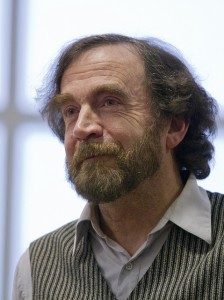T. Glen Lawson, Dana Professor
 Established in 1966 with an endowment funded by the Charles A. Dana Foundation, the position recognizes and supports outstanding teaching and scholarship in any discipline. Up to six faculty members may hold Dana professorships at any time.
Established in 1966 with an endowment funded by the Charles A. Dana Foundation, the position recognizes and supports outstanding teaching and scholarship in any discipline. Up to six faculty members may hold Dana professorships at any time.
From remarks by Thomas J. Wenzel, Professor of Chemistry, who also holds a Dana Professorship, at a March 8, 2012 appointed to named professorships. (Read about the event.)
Glen and I have overlapped for almost 25 years at Bates and I have always valued the interactions I have had with him during this time. To me, Glen embodies the teacher-scholar model we desire in faculty members.
Glen’s scholarly interests involve the study of viruses. When we hear the word virus, we generally associate it with something bad, and at times the results of viruses are tragic. Glen’s research involves trying to understand fundamental aspects of how viruses function, and the outcomes of the work he has completed at Bates are significant. Some of his work has involved studies on the polio virus, although I understand that the strain he studies has been modified to no longer be dangerous to Glen and his student collaborators. The type of research he does is tremendously demanding, meticulous and tedious, and requires a long time to bring projects to completion. This type of work is usually done by a professor working with an army of post-docs and graduate students at research institutions with the state-of-the-art instrumentation and infrastructure needed to complete the work. That Glen has been able to become recognized in his field and complete the body of work that he has, working with the limited infrastructure that exists at a place like Bates, and collaborating with undergraduate students, is nothing short of amazing. He has many publications from his work at Bates, most if not all of which have undergraduate students as coauthors.
I do not think I know anyone more passionate about his research than Glen. The energy he puts into his scholarly work is awe-inspiring.
Glen is also an outstanding and dedicated teacher. I think two stories illustrate important aspects of his teaching. The first involves students taking his second semester biochemistry course. In the lab, the students are divided into pairs and they must execute an original project. They go to the literature to learn about possible ideas, write a proposal that is peer-reviewed and critiqued by other students in the class, are given a budget and after final approval of their plan, they then carry out the project. Through this experience, students in Glen’s class learn what it really means to do science. This prepares them with the meaningful skills they will need after graduation to excel as scientists. And Glen’s students do go on to excel in their activities after Bates. The second involves something that occurred a few years back. One morning while crossing the quad I thought I had been transported back 150 years through some sort of time machine, as crossing the Quad was someone dressed in full Union soldier regalia from the Civil War. Glen has a passionate interest in the history of the Civil War and he and his wife Carolyn participate in Civil War re-enactments. Glen also teaches a first-year seminar on the state of medicine and health care at the time of the Civil War, and the morning I saw him crossing the Quad he was on his way to teach his first-year seminar. This episode may also illustrate Glen’s somewhat quirky sense of humor, which if anything, is further endearing to his students and colleagues.
I remember when I wrote my letter for Glen’s promotion to full professor, I stated that Glen had the attributes that should result in him someday being appointed to an endowed chair position. I am so glad to see that day come, as it is an honor he so deserves.